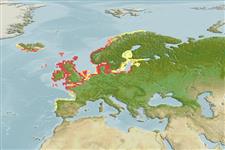Environment: milieu / climate zone / profondeur / distribution range
Écologie
marin; saumâtre démersal; océanodrome (Ref. 51243); profondeur 6 - 30 m (Ref. 57178). Temperate; 80°N - 37°N, 25°W - 36°E
Northeast Atlantic: Murman and Spitzbergen to Portugal, including Iceland and much of the Baltic.
Length at first maturity / Taille / Poids / Âge
Maturité: Lm 13.0, range 11 - 15 cm
Max length : 40.0 cm SL mâle / non sexé; (Ref. 4674); common length : 20.0 cm TL mâle / non sexé; (Ref. 4645)
Tip of pectoral fin reaches the front end of the dorsal fin. Dark spot on each side of the snout. Two pointed teeth in the palate. Upper jaw not protractile (Ref. 35388).
Body shape (shape guide): elongated.
Inshore, including the inter-tidal zone and estuaries, and offshore to about 60 m depth. Commonly associated with Ammodytes species. Feeds initially on zooplankton, later small fish (clupeids and ammodytids) dominate the diet. Summer batch spawner. Used mainly for fishmeal and oil, but also utilized fresh and pan-fried for human consumption (Ref. 9988).
Muus, B.J. and P. Dahlström, 1974. Collins guide to the sea fishes of Britain and North-Western Europe. Collins, London, UK. 244 p. (Ref. 173)
Statut dans la liste rouge de l'IUCN (Ref. 130435: Version 2025-1)
Menace pour l'homme
Harmless
Utilisations par l'homme
Pêcheries: hautement commercial; appât: occasionally
Outils
Articles particuliers
Télécharger en XML
Sources Internet
Estimates based on models
Preferred temperature (Réf.
123201): 8.8 - 12.8, mean 10.3 °C (based on 476 cells).
Phylogenetic diversity index (Réf.
82804): PD
50 = 0.7500 [Uniqueness, from 0.5 = low to 2.0 = high].
Bayesian length-weight: a=0.00324 (0.00174 - 0.00601), b=3.00 (2.84 - 3.16), in cm total length, based on LWR estimates for this species & (Sub)family-body (Ref.
93245).
Niveau trophique (Réf.
69278): 4.0 ±0.1 se; based on diet studies.
Generation time: 2.7 ( na - na) years. Estimated as median ln(3)/K based on 1
growth studies.
Résilience (Réf.
120179): Milieu, temps minimum de doublement de population : 1,4 à 4,4 années (tm=2; Fec=35,000).
Fishing Vulnerability (Ref.
59153): Low to moderate vulnerability (32 of 100).
🛈
Nutrients (Ref.
124155): Calcium = 50.7 [28.6, 103.2] mg/100g; Iron = 0.402 [0.237, 0.669] mg/100g; Protein = 18.9 [17.2, 20.8] %; Omega3 = 0.405 [0.217, 0.718] g/100g; Selenium = 10.1 [4.9, 20.7] μg/100g; VitaminA = 20.1 [7.0, 60.0] μg/100g; Zinc = 0.594 [0.420, 0.824] mg/100g (wet weight);
